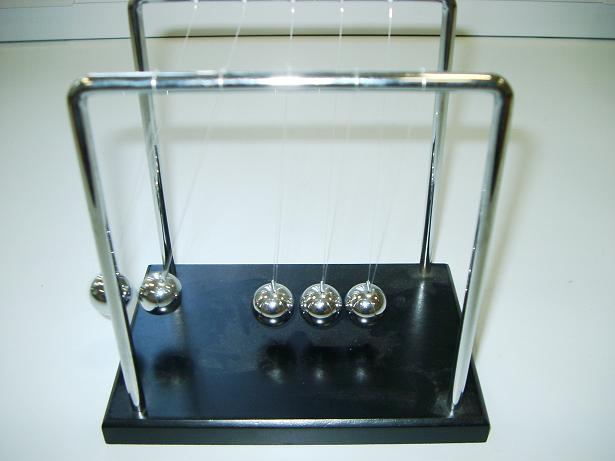Collision balls
This demonstration shows the use of the principles of conservation of energy and conservation of momentum.


Fig. 13-3: Collision balls
Fig 13-3 shows a Newton’s cradle which consists of five identical stainless steel balls suspended from the above and arranged in a row with each ball just touching its neighbour(s). When one pulls a ball back and releases it, it collides with the row of the remaining balls, ejecting one at the far end. If one pulls two balls and releases them, they eject two balls at the far end as shown in Fig. 13-3. Lifting and releasing three balls ejects three balls at the far end, and pulling four ejects four.
First consider the collision between two identical balls of mass m , one moves with initial velocity ![]() and the other is at rest with
and the other is at rest with ![]() . After the collision, the two balls move with velocities
. After the collision, the two balls move with velocities ![]() and
and ![]() respectively. Conservation of momentum requires:
respectively. Conservation of momentum requires:
![]() or
or ![]()
Conservation of energy requires:
![]() or
or ![]()
Squaring the first equation and subtracting the second equation leads to:
![]() or
or ![]()
As ![]() ,
, ![]() . This shows that after collision the first ball will be at rest [13.5, 13.6].
. This shows that after collision the first ball will be at rest [13.5, 13.6].
Now consider the case of several balls. Let ![]() be the total mass of the balls launched with velocity
be the total mass of the balls launched with velocity ![]() and
and ![]() be the total mass of the balls ejected with velocity
be the total mass of the balls ejected with velocity ![]() . Noting that after collision,
. Noting that after collision, ![]() becomes stationary, i.e.
becomes stationary, i.e. ![]() and using conservation of momentum and conservation of energy gives:
and using conservation of momentum and conservation of energy gives:
![]()
![]()
Squaring the first equation and subtracting ![]() times the second equation gives:
times the second equation gives:
![]()
This equation shows that the number of balls ejected is equal to the number of balls launched if all the steel balls are the same size, as shown in Fig.13-3.
